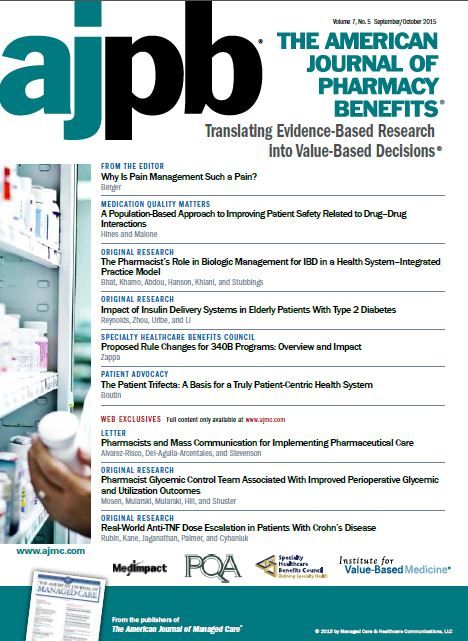
Publication
Article
AJPB® Translating Evidence-Based Research Into Value-Based Decisions®
A Population-Based Approach to Improving Patient Safety Related to Drug—Drug Interactions
Some medication combinations are a source of preventable drug-related harm. A multifaceted approach is needed to address this quality-of-care issue.
Exposure to drug-drug interactions (DDIs) is a significant cause of preventable drug-related harm.1 Although the consequences of DDIs can range from no untoward effects to life-threatening outcomes, studies indicate that DDIs are associated with significant morbidity and mortality and increased healthcare utilization and costs.2-4 Furthermore, DDIs have also been found to be an important factor leading to hospital admissions.3 These findings are unfortunate given that DDIs are often avoidable, so the true prevalence of exposure and harm from DDIs is likely underestimated.
Tip of the Iceberg
There are several reasons to believe that the prevalence and potential risk of DDIs are underestimated. First, the clinical presentation of adverse events caused by DDIs can be obscured by the variable and wide array of potential outcomes, including serious adverse effects (eg, sudden death, seizures, arrhythmias, delirium, gangrene), poor tolerability (ie, sensitivity to the adverse effects of the drug), lack of effectiveness (ie, resistance to the therapeutic effects of the drug), and withdrawal symptoms or drug-seeking behaviors.5 Symptoms can also mimic or lead to a misdiagnosis of a new condition and healthcare professionals might not suspect that the new symptoms are attributable to an underlying DDI.5 Second, medications used on an as-needed basis can create transient or intermittent effects.6 Third, healthcare professionals may not be aware of all of the medications a patient is consuming, making it more difficult to detect the presence of a DDI. Fourth, there are currently no diagnosis codes to reflect that a DDI has occurred and is the underlying etiology when harm has occurred. As a consequence, analyses of administrative health records will conceal DDIs as a causative factor.6
Although DDIs are a primary medication-related concern for patients,7 many prescribers underestimate the risks and are not adequately knowledgeable about DDIs.8,9 Despite their recognized role as drug therapy experts, pharmacists are also limited in their ability to identify DDIs and often do not intervene when clinically relevant interactions are recognized.10-12 Furthermore, DDI alerts intended to support clinical decision making within electronic prescribing and pharmacy systems are fraught with problems, including poor usability, variable performance across systems, and production of alerts with questionable clinical relevance while failing to detect all potentially serious DDIs.13-16 Excessive DDI alerting also contributes to cognitive overload and contributes to a general lack of appreciation by healthcare professionals of the true safety concern.
The safety concern posed by DDIs will continue to grow in importance as the complexity and uniqueness of medication regimens increases with the aging population.17 In 2014, the average number of prescriptions filled per person in the United States was 12.7, with an average of 27.9 prescriptions filled by individuals 65 years and older.18 This degree of medication use elevates the number of potential drug-related problems, including potentially serious DDIs. The holes in the medication safety net with respect to serious DDIs occur throughout the healthcare system and, therefore, a multifaceted approach is needed to address this quality of care issue.
What Is PQA Doing to Address DDIs?
The Pharmacy Quality Alliance (PQA) is a nonprofit multi-stakeholder, consensus-based membership organization that collaboratively promotes appropriate medication use and develops strategies for measuring and reporting performance information related to medication. PQA evaluates its measures on an annual basis to ensure they are updated to reflect current evidence and standards. The PQA DDI performance measure has been designed for monitoring and improving the quality of care across populations of patients in health plans, pharmacy benefit managers, and pharmacy systems. Originally developed in 2006, the measure was revised in 2009, based in part on identification of clinically important DDIs by Malone et al.19 Since then, another list of high-priority DDIs was developed by Phansalkar et al.20 This work was commissioned by the Office of the National Coordinator for Health Information Technology (ONC) to identify a set of critical interactions that could be implemented in drug knowledgebases for use in electronic health records. Recognizing the specific purpose of the PQA DDI list and the interest in harmonizing with the interactions identified by the ONC-supported work, PQA recently collaborated with researchers at the University of Arizona College of Pharmacy to comprehensively review and update the DDI performance measure.
Comprehensive updating of the PQA DDI performance measure was a major undertaking because of the challenges associated with identifying clinically relevant DDIs. Determining the most important clinically relevant DDIs on which to focus interventions was also challenging for several reasons. First, clinical relevance is highly variable depending on patient characteristics, clinical setting, and other contextual factors. Second, high-quality evidence for DDIs is generally lacking, making traditional evidence-based assessments difficult.21 Third, editors of drug compendia and clinical decision support knowledgebases use differing approaches to evaluate the clinical relevance of DDIs.22 DDIs are also sometimes inappropriately generalized to other drugs within the same therapeutic or pharmacologic class.21 Furthermore, not surprisingly, studies have demonstrated considerable inconsistencies among DDI information sources.23,24 In light of these challenges, an external technical expert panel was convened by the University of Arizona on behalf of PQA to obtain consensus on the DDIs for the performance measure update.
Thirty-four individuals with expertise in DDIs, clinical pharmacology, drug information, healthcare quality, and health information technology participated in the expert panel. Panel members represented backgrounds such as academia, compendia/knowledgebase editors, healthcare providers, and government agencies. Guiding principles provided to the expert panel for selection of the DDIs for the performance measure are summarized in the
Table
. The expert panel was instructed to include drug pairs for which serious adverse effects have been reported or may be expected based on known pharmacology of the drugs involved. Therefore, co-prescription of the selected drug pairs has an unfavorable balance of benefits and harms for many, if not most, individuals, particularly in light of available pharmacologic and nonpharmacologic alternatives. In some cases, the drug pairs are almost always a poor choice. However, there are individuals in whom combined use of these medications may be appropriate. Thus, the drug pairs are a potential serious safety concern (ie, potentially inappropriate) and merit special scrutiny, are not universally unsafe or inappropriate in all patients.
Intended Use of the PQA DDI Performance Measure
Because the PQA DDI performance measure is applied at the population level, it is not intended to guide the care of any given patient at any point in time. Rather, through application to large numbers of patients, average use can be measured and compared across systems of care. Healthcare systems can use this information to improve care by decreasing the frequency of patient exposure to DDIs that are a potential safety concern.
The PQA DDI measure is neither a list of medications that should never be co-prescribed/dispensed, nor a list of drug combinations that are always inappropriate. Although lower rates of co-prescription for a population are preferable, there are circumstances in which the combined use of these medications for a patient may be reasonable and the target rate for performance measurement is not 0%. Balancing the risks and benefits needs to be done at the patient level, and given the complexity of medical care, these attributes are not fully captured in current healthcare systems. Completely eliminating co-prescription of these medications may be inappropriate and could negatively affect quality of care by restricting access to medications on the list that are being used in appropriate ways. This would also create a troublesome burden for prescribers and pharmacists. The intent of the PQA DDI measure is to reduce the overall prevalence of potential DDIs by raising awareness of combinations that should undergo another level of scrutiny before being dispensed to patients.
As in all medication therapy decisions for individual patients, clinical judgment is required. A drug pair considered “potentially serious” may not always be a bad choice; the risks of DDIs on the PQA list vary with the situation of each individual patient, and the importance of avoiding a given drug pair varies accordingly. The PQA DDI performance measure should serve as a starting point for a comprehensive process of improving medication safety; it should not be considered as a comprehensive set of potentially serious DDIs. Furthermore, the measure should not be used as a punitive tool, as definitive criteria for prescribing or pharmacy clinical decision support systems, or for prescription drug plan coverage decisions.17 Hard stops that prevent prescribers and pharmacists from selecting these drug pairs are not recommended due to potential unintended consequences.25 Such restrictive strategies also undercut the quality improvement and patient safety function of the performance measure.
CONCLUSIONS
Co-prescribing medications that are potentially serious DDIs is a safety concern for both individual patients and populations of patients, yet healthcare professionals often underestimate the prevalence and risks of DDIs. PQA is updating its DDI performance measure using a panel of experts to identify a subset of DDIs that are a potentially serious safety concern and that have an unfavorable balance of benefits and risks for most individuals. The PQA DDI performance measure is a population-based approach to improve patient safety by encouraging healthcare professionals, health plans, pharmacy benefit managers, and health systems to be more cognizant of the potential negative consequences of clinically relevant DDIs.
Acknowledgments
See
eAppendix
(available at www.ajmc.com).

Newsletter
Stay informed on drug updates, treatment guidelines, and pharmacy practice trends—subscribe to Pharmacy Times for weekly clinical insights.
2 Commerce Drive
Cranbury, NJ 08512
All rights reserved.





